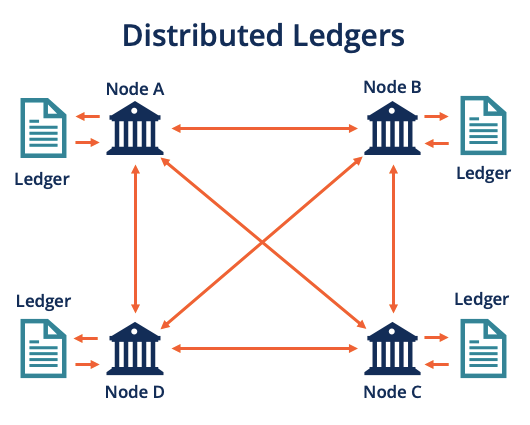Understanding Distributed Ledger Technology
This article was published as a part of the Data Science Blogathon.
Introduction
A ledger is an accounting record that lists debits and credits for the categorized and condensed data from the journals. Another name for it is the second book of entries.
The information needed to create financial statements is included in the ledger. It accounts for the owner’s equity, owners’ liabilities, income, and costs. The chart of accounts refers to this comprehensive list of accounts. Every open account on the list is represented in the ledger.
This concept developed through time into the ledgers that are today known as a company entity’s primary Book of Accounts. Ledger accounting, which records credits and debits on a company’s ledger, is a prevalent practice today. Every company has a separate ledger and transaction book. You would need to check the records of two companies, one with a credit and the other with a debit, to certify that a transaction actually occurred. Due to this, it is known as “double-entry ledger accounting.” The input and output of the accounts are essentially recorded in the ledger.
What is a Distributed Ledger?
A distributed ledger is a shared and synced database by several persons across various sites, institutions, or countries. It enables the public to be present during transactions.

( Image: https://corporatefinanceinstitute.com/resources/knowledge/other/distributed-ledgers/)
A distributed ledger differs from a centralized ledger, the type of ledger used by most businesses. Because it provides a single point of failure, a centralized ledger is more vulnerable to cyber assaults and fraud.
With the advancement of technology, the information saved on computers is becoming cryptographically secure, quick, and decentralized. This has led to the improvement and rise of Distributed Ledger Technology.
What is Distributed Ledger Technology (DLT)?
Distributed Ledger Technology (DLT) is a novel and quickly expanding method of recording and exchanging data across numerous data stores. Each data store (i.e., ledgers) has identical data records, which are maintained and controlled by a distributed network of computer servers known as nodes. Consider DLT to be a distributed database with specific features.
DLT is a digital method for documenting asset transactions in which the transactions and their information are stored in several locations simultaneously. Distributed ledgers, unlike traditional databases, lack a central data repository and administrative functions.
Each node in a distributed ledger analyses and validates every item, recording each item and reaching an agreement on its authenticity. A distributed ledger can be used to store both static and dynamic data, such as financial transactions.
How Distributed Ledger Technology (DLT) works?
The technology generates an immutable database, which means that once information is stored, it cannot be removed, and any revisions are preserved for posterity.
By shifting record-keeping from a single, authoritative place to a decentralized system in which any relevant entities may read and amend the ledger, this architecture marks a substantial change in how information is received and shared. As a result, everyone else can see who is using and altering the ledger.
DLT’s openness fosters a high degree of confidence among participants and almost eliminates the possibility of fraudulent activity occurring in the ledger.
As a result, DLT eliminates the requirement for entities utilizing the ledger to rely on a trusted central authority or an outside, third-party provider to execute that job and act as a check against manipulation.
History of Distributed Ledger Technology (DLT)?
In the decade following the 2009 debut of bitcoin, a cryptocurrency backed by blockchain technology that was the first to demonstrate that the technology not only functioned but could scale and stay safe, interest in distributed ledger technology expanded considerably.

( Image: https://www.niis.org/blog/2021/10/3/theres-no-distributed-ledger-technology-dlt-in-x-road)
- Since then, firms across sectors have been experimenting with DLT and how it might be utilized in enterprise operations. Supply chain management was frequent use in the financial services, healthcare, and pharmaceutical sectors.
- It’s worth noting that the notion of a distributed ledger is not new. Organizations have historically collected and stored data in numerous locations on paper or in siloed software, only periodically bringing the data together in a centralized database. For example, a firm may have various bits of data stored by each division, with divisions submitting that data to a centralized ledger only when necessary.
- Similarly, numerous entities that collaborate often keep their data and only contribute it to a central ledger managed by an authorized party when asked or necessary.
The most significant innovation of DLT is its potential to reduce or eliminate the typically time-consuming and error-prone processes required to reconcile the various contributions to the ledger, ensuring that everyone has access to the most recent version and that its correctness can be trusted.
Importance of Distributed Ledger Technology (DLT)?
DLT is very important for the future world. By altering some of the principles of how businesses gather and exchange the data that goes into their ledgers, distributed ledger technology may significantly enhance record-keeping.
- The finance industry might become more trustworthy, efficient, and robust with the help of distributed ledger technology. The use of technology can enhance aspects of the financial industry such as cross-border payments and transaction processing without the participation of a third party.
- Additionally, it can aid in bringing traditional financial services within reach of the unbanked population, who are now excluded from them.
- The distributed ledger technology may also be used to enhance existing procedures in several other industries, including manufacturing, sustainable energy, and government finance systems.
- Because distributed ledger technology does not require a centralized authority, it can speed up transactions. Additionally, it can lower transaction costs.
- Distributed ledger technology is considered a more secure approach to managing records since it holds the records at each network node, making it exceedingly difficult to manipulate or launch an effective assault. Distributed ledger technology offers a more open way of managing records since the data is shared and viewable across a network.
- Distributed ledger technology, according to experts, may be used for tax collecting, voting procedures, transferring property titles, and social benefits distribution. Legal papers can also be processed and executed using it.
Prospects of Distributed Ledger Technology (DLT)
Digital ledger technology (DLT) supporters assert that businesses outside of finance may also use them. Governmental organizations are using technology to investigate methods to document transactions like real estate title transfers.
- Healthcare institutions are testing DLT to provide a more effective method of updating patient records. For retaining supply chain data, several firms are exploring DLT. And the legal industry is investigating how it can process and execute legal papers using DLT.
- Additionally, according to experts, technology helps people gain better control over their personal information by enabling them to selectively disclose portions of their data as needed, restrict access to their records, and set temporal limits on how long information is accessible to third parties.
- Another potential advantage of DLT for MSMEs is its ability to circumvent traditional procedures or funding sources. DLT enables firms and individuals worldwide to conduct direct, peer-to-peer transactions without the need for traditional institutions. As a result, DLT enables MSMEs that do not have access to bank finance to access the worldwide trade market through other ways.
Types of Distributed Ledger Technology (DLT) other than Blockchain:
Now that we have read a lot about DLT, let us see the DLTs other than Blockchain:
1. Hashgraph:
Hashgraph is another type of DLT that is available on the market. It is essentially a proprietary algorithm with the ability to give all of the benefits of Blockchain (decentralization, security, and distribution) without sacrificing transaction speed.
2. Holochain:
3. Direct Acyclic Graph (DAG):
Conclusion:
DLT can change how businesses, organizations, and governments operate. Modern businesses and companies need a lot of record keeping to run their operations. DLT can serve as a great tool for this purpose. The features, reliability, and security provided by DLT are unmatched. DLT can solve many problems in keeping records nowadays and help make business processes more efficient.
To sum up, we read:
- Since the real-time exchange of data is made possible by distributed ledger technology, the ledger is constantly up to date.
- Because each participating node can see these changes, it also promotes transparency.
- It is inherently more secure since it does away with centralized ledgers’ single point of failure and single target for hackers and manipulation.
- DLT might address persisting financial sector difficulties and redefine the responsibilities of financial sector players.
- DLT has the potential to alter a wide range of other industries, including manufacturing, government financial management systems, and sustainable energy.
Because there is no longer a need to go via a central authority or middleman, distributed ledger technology offers the potential to speed up transactions. DLT might also lower transaction costs in a similar manner. DLT applications will most likely gradually replace manual and inefficient processes and activities first.
The media shown in this article is not owned by Analytics Vidhya and is used at the Author’s discretion.








